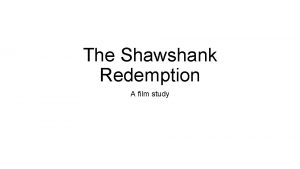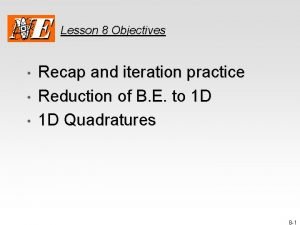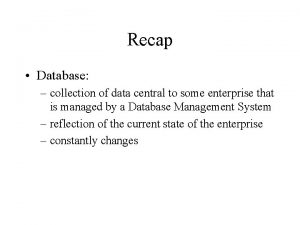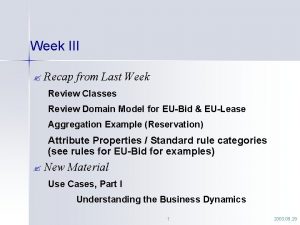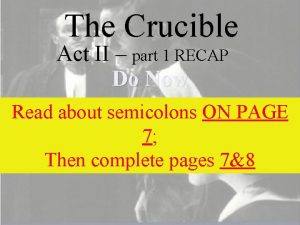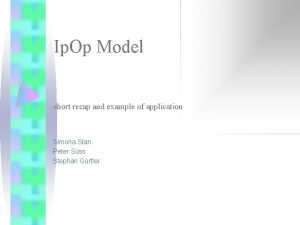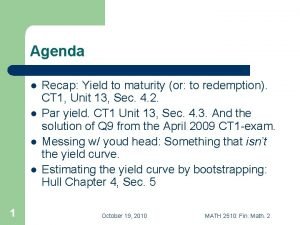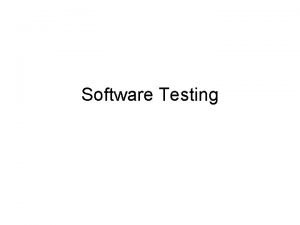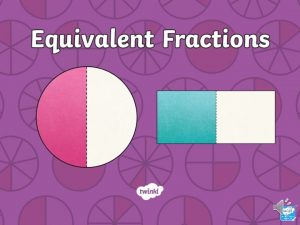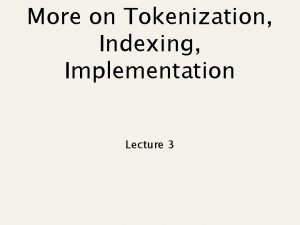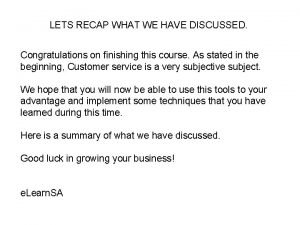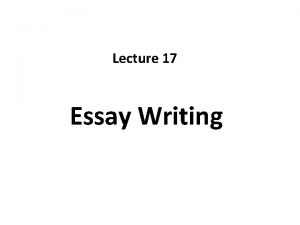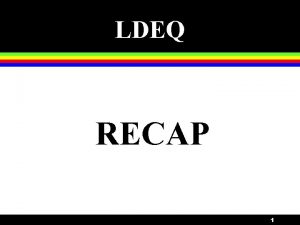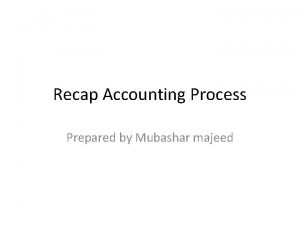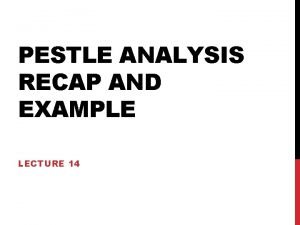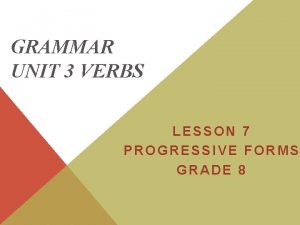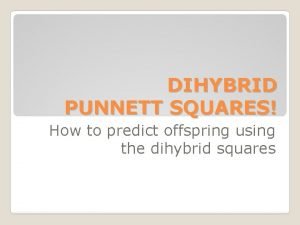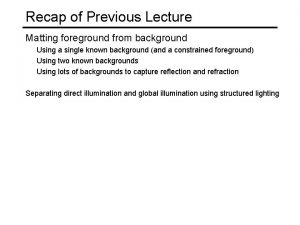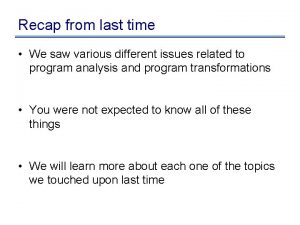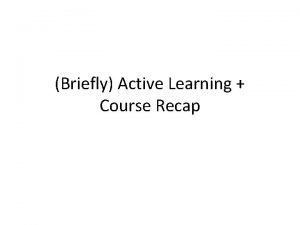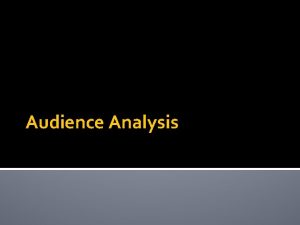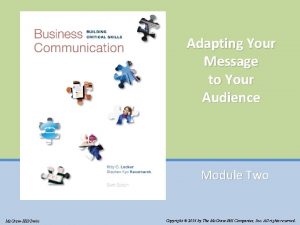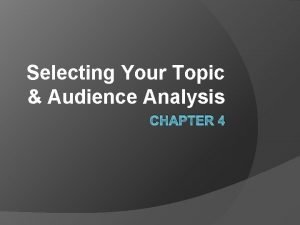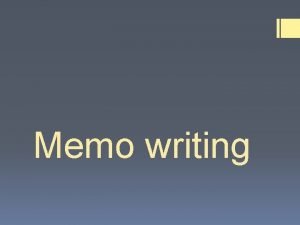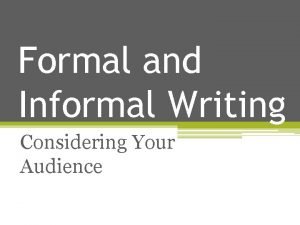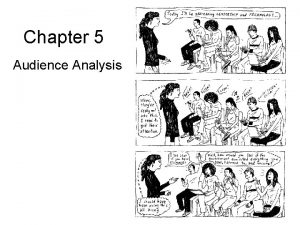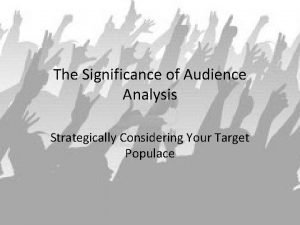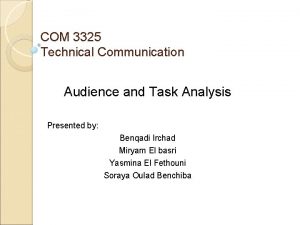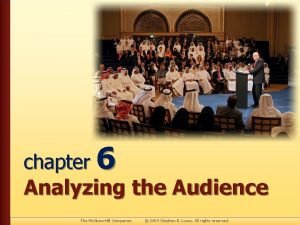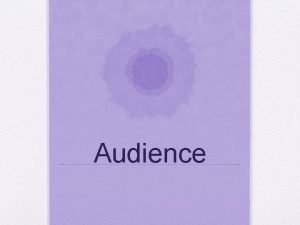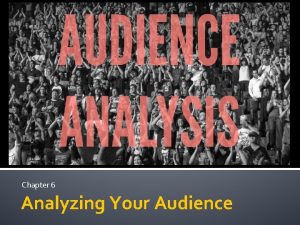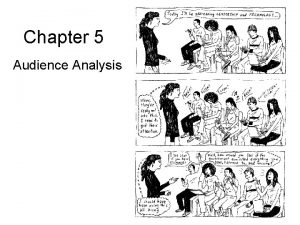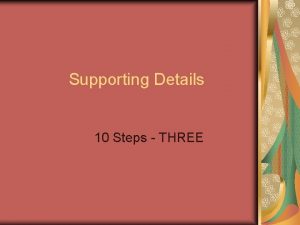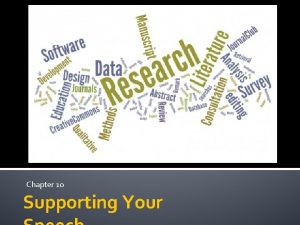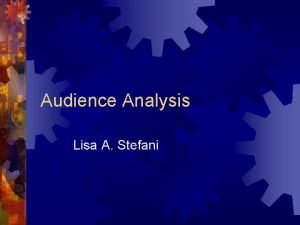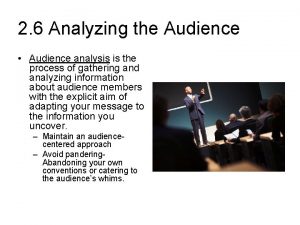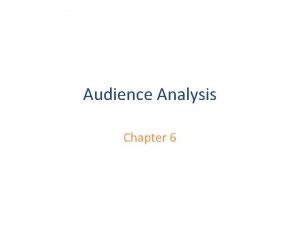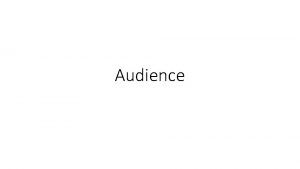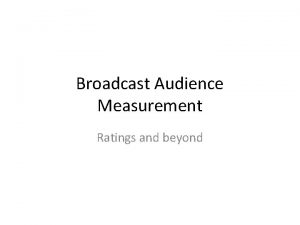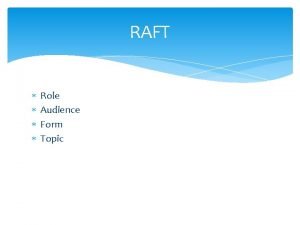Audience Analysis Recap Audience Analysis Recap Supporting Your

















































- Slides: 49


Audience Analysis Recap

Audience Analysis Recap


Supporting Your Ideas Testimonies and Examples Working with the information you find and how to use it

Facts • “units of information that are verified through independent observation” • Is it from expert testimony? • Who are you citing? Are they experts of the topic you are discussing? • Is it statistical? • • “According to x, 70% of people are…” “x conducted a study and find that 1 in 4 people do…”

Facts 2 • Dihydrogen Monoxide Research Center


Disinformation • “pseudo-discovered that have been willfully fabricated and packaged as ‘news’ to advance a hidden agenda”

Interpretation v. Opinion • What is the difference?



• Can interpretations be wrong?

• According to the police report, “the criminal hit the man with the stick”

• According to the police report, “the criminal hit the man with the stick”

• According to the police report, “the criminal hit the man with the stick”

Testimony Know who is saying what and its importance

Expert Testimony • “when experts or persons with qualified training or experience speak as authorities on a subject” (p. 152)

Reluctant Testimony • “when experts testify against and despite their apparent self-interest” (p. 153)

Lay Testimony • “represents the wisdom of ordinary people” (p. 153)

Lay Testimony 2 • According to my sister, “…” • According to my parents, “…” • According to my neighbor, “…” • Individually, these cannot be used as facts.

Lay Testimony 3 • But… with strength in numbers they can. • If your research takes you on paths that uses lay testimony, think of the quantity. • For example, think tanks like Pew Research Center have research (in the form of surveys) that aggregates lay testimony (in mass volume) • For a list of other U. S. based think tanks: click here

Prestigious Testimony • “associates your message with the words of an admired figure” (p. 154) • • Typically used for ceremonial speeches (will talk more about this after persuasive speeches) However, this can be one effective way to open or close a speech • Condition 1: make sure the prestigious testimony is related to your speech. Do not quote Abraham Lincoln unless there is a clear connect between his words and what you are talking about • Condition 2: make sure the prestigious testimony enhances your speech. Do not quote Ghandi if it is distracting from understanding the point you are trying to make

Quoting in your speech • While you speak, use… direct quotation • • “According to Pew Research Center…” “According to the NSA…”

Quoting in your speech • While you speak, you can also use… paraphrasing (to balance out too many direct quotations) • Pew Research Center finds a small number of people believe in the news about science from the sources they read.

Quoting in your speech • Pew Research Center still gets verbally cited when you paraphrase information

BAD: Quoting out of context • Pew Research Center believes only few people see science as accurate

FIXED: Quoting out of context • Pew Research Center found majority of Americans that get science news, a smaller portion believe it is accurate

Examples Verbally constructing examples to enhance persuasion

Brief Example • “mentions a specific instance to demonstrate a more general statement” • E. g. , We need to fund the EPA. The record high it has ever been is barely 1% of all federal spending according to the White House Office of Management and Budget. 1% is the clean water we can supply to Flint, Michigan

Brief Example • “mentions a specific instance to demonstrate a more general statement” • E. g. , We need to fund the EPA. The record high it has ever been is barely 1% of all federal spending according to the White House Office of Management and Budget. 1% is the clean water we can supply to Flint, Michigan (similar example p. 156)

Extended Example • A very detailed example • Usually when supporting a sub-claim you are making that is complex so you sidestep into an extended example to further explain yourself • E. g. , The FCC should implement stricter regulations on consumer drones – for good reason too. Take the case when an individual accidentally crashed his friend’s drone onto the White House lawn. According to the New York Times, “The small drone, called a DJI Phantom, evaded White House radar that is calibrated to warn of much bigger threats, like an airplane or a missile. ” Times are changing. The White House radar could not even detect a drone this small flying into their airspace. What if it was carrying explosives?

PORTAL TO LAST WEEK: WHAT IS THE CLAIM, DATA, AND WARRANT? • E. g. , The FCC should implement stricter regulations on consumer drones – for good reason too. Take the case when an individual accidentally crashed his friend’s drone onto the White House lawn. According to the New York Times, “The small drone, called a DJI Phantom, evaded White House radar that is calibrated to warn of much bigger threats, like an airplane or a missile. ” Times are changing. The White House radar could not even detect a drone this small flying into their airspace. What if it was carrying explosives?

Factual Examples • What actually happened? • Trump dehumanizes communities outside Mainland U. S. • For example, according to NBC News, Trump’s recent visit to Puerto Rico showed him launching paper towels to victims of hurricane Maria as if they were free t-shirts at a concert.

Hypothetical Example • “Not a real example as much as it is representative of actual people, situations, or events”

Hypothetical Example

Lesson: Know. The. Data. • Know claim, data, and warrant • Know your audience • Know how to support your ideas

Activity: Constructing Persuasion Gun control in the U. S. 1. You and your group come up with a thesis (main claim) defending or challenging gun control in the U. S. 2. Review the infographic (on the next slide) and brainstorm 1 sub-claim (main point) and a sub-point that uses one of the facts. Also, establish a warrant (connection between the data and your main point; how does it support your claim? ). Finally, integrate verbal examples. Delegate a person to present each element: One person state the group’s claim; one person state the group’s main point; one person state which fact was used; one person state the group’s warrant; and one person create an example strategy from today’s lesson (brief, extended, factual, or hypothetical).


Persuasive Speech Outline Due: Wednesday, November 1 at 7: 00 am

Persuasive Outline • For basic assignment details, refer to document I emailed. • Additional information for you to know… • • Outline redemption intervention: use that same format going forward with this speech For other elements of what I look for, see the remainder of this Power. Point

Persuasive Outline 2 • Introduction: • Thesis (Preview + Main Claim): Our current president exhibits traits unfit for president: he is a sociopath, incompetent, and does not forward respect to other sovereign leaders. Donald Trump is mentally unstable and ought to be impeached

Persuasive Outline 3 • Introduction: • Thesis (Preview + Main Claim): Our current president exhibits traits unfit for president: he is a sociopath, incompetent, and does not forward respect to other sovereign leaders. Donald Trump is mentally unstable and ought to be impeached Transition: No president in history has matched Donald Trump’s level of sociopathy.

Persuasive Outline 4 • Introduction: • Thesis (Preview + Main Claim): Our current president exhibits traits unfit for president: he is a sociopath, incompetent, and does not forward respect to other sovereign leaders. Donald Trump is mentally unstable and ought to be impeached Transition: No president in history has matched Donald Trump’s level of sociopathy. • Main Point 1 (Sub-Claim 1): Donald Trump’s sociopathic tendencies are problematic for functioning relations with the world

Persuasive Outline 5 • Introduction: • Thesis (Preview + Main Claim): Our current president exhibits traits unfit for president: he is a sociopath, incompetent, and does not forward respect to other sovereign leaders. Donald Trump is mentally unstable and ought to be impeached Transition: No president in history has matched Donald Trump’s level of sociopathy. • Main Point 1 (Sub-Claim 1): Donald Trump’s sociopathic tendencies are problematic for functioning relations with the world • Sub-Point 1 (Data + Warrant): According to Web. MD, “Sociopaths are less able to play along. They make it plain that they’re not interested in anyone but themselves. They often blame others and have excuses for their behavior. ” Trump has demonstrated this when he complained about Puerto Rico throwing “the budget a little out of whack” due to damages sustained during hurricane Maria

Anatomy of the Persuasive Outline • Introduction: ________________________________ • Thesis: MAIN CLAIM: _________________________________ Transition: __________________________________ • • Main Point 1 (Sub-Claim 1): __________________________ • • Sub-Point 1: QUOTE ONE SOURCE (Data) + PROVIDE ONE EXPLANATION (Warrant) Sub-Point 2: Repeat. Main Point 2 (Sub-Claim 2): Repeat. Transition: __________________________________ • Main Point 3 (Sub-Claim 3): Repeat. Transition: __________________________________ • Conclusion: _________________________________

• Make sure data demonstrates the three traits of a reliable Introduction: ________________________________ source. Remember: objectivity, authority, • Thesis: MAIN CLAIM: _________________________________ and accuracy Transition: __________________________________ • • Main Point 1 (Sub-Claim 1): __________________________ • • Sub-Point 1: QUOTE ONE SOURCE (Data) + PROVIDE ONE EXPLANATION (Warrant) Sub-Point 2: Repeat. Main Point 2 (Sub-Claim 2): Repeat. Transition: __________________________________ • Main Point 3 (Sub-Claim 3): Repeat. Transition: __________________________________ • Conclusion: _________________________________

• Explain how the fact, data, statistic supports Introduction: ________________________________ your claim • Thesis: MAIN CLAIM: _________________________________ Transition: __________________________________ • • Main Point 1 (Sub-Claim 1): __________________________ • • Sub-Point 1: QUOTE ONE SOURCE (Data) + PROVIDE ONE EXPLANATION (Warrant) Sub-Point 2: Repeat. Main Point 2 (Sub-Claim 2): Repeat. Transition: __________________________________ • Main Point 3 (Sub-Claim 3): Repeat. Transition: __________________________________ • Conclusion: _________________________________

• One fact and one warrant per sub-point (2 sub-point max per Main Point) x 3 Main Introduction: ________________________________ Points • Thesis: MAIN CLAIM: _________________________________ • • Sub-Point 1: QUOTE ONE SOURCE (Data) + PROVIDE ONE EXPLANATION (Warrant) You should have 6 sources and 6 warrants (NOTE: no Transition: __________________________________ fewer than 5 sources for the Main Point 1 (Sub-Claim 1): __________________________ speech) • • Sub-Point 2: Repeat. Main Point 2 (Sub-Claim 2): Repeat. Transition: __________________________________ • Main Point 3 (Sub-Claim 3): Repeat. Transition: __________________________________ • Conclusion: _________________________________
 Invoked audience
Invoked audience Give us your hungry your tired your poor
Give us your hungry your tired your poor Shawshank redemtion summary
Shawshank redemtion summary Summary of chapter 8 the great gatsby
Summary of chapter 8 the great gatsby Segmented pricing
Segmented pricing What is the purpose of an iteration recap
What is the purpose of an iteration recap Recap intensity clipping
Recap intensity clipping 60 minutes recap
60 minutes recap Recap database
Recap database Differentiation recap
Differentiation recap Introduction for recap
Introduction for recap Recap introduction
Recap introduction Recap from last week
Recap from last week The crucible symbols
The crucible symbols Ezekiel cheever motivation
Ezekiel cheever motivation Logbook recap example
Logbook recap example Ytm recap
Ytm recap Black box recap
Black box recap Fractions recap
Fractions recap Recap
Recap Y axis on a graph
Y axis on a graph Recap indexing scans
Recap indexing scans Lets recap
Lets recap Recap poster
Recap poster What is a essay
What is a essay Ldeq recap
Ldeq recap Romeo and juliet pee paragraphs
Romeo and juliet pee paragraphs Recap accounting
Recap accounting Example of recap
Example of recap Let's recap
Let's recap Let's recap
Let's recap Punnett square percent
Punnett square percent Recap background
Recap background Realism vs anti realism
Realism vs anti realism Saw recap
Saw recap Briefly recap
Briefly recap Hellhound macbeth
Hellhound macbeth Why is it important to analyze your audience
Why is it important to analyze your audience 'adapting the message to your audience
'adapting the message to your audience Respect the audience
Respect the audience Adapting to your audience
Adapting to your audience Conclusion about presentation
Conclusion about presentation Knowing your audience
Knowing your audience Steps of audience analysis
Steps of audience analysis Audience of sample memorandum
Audience of sample memorandum Informal audience analysis
Informal audience analysis Affiliation audience analysis
Affiliation audience analysis Situational audience analysis example
Situational audience analysis example Audience analysis in technical communication
Audience analysis in technical communication Situational audience analysis
Situational audience analysis


